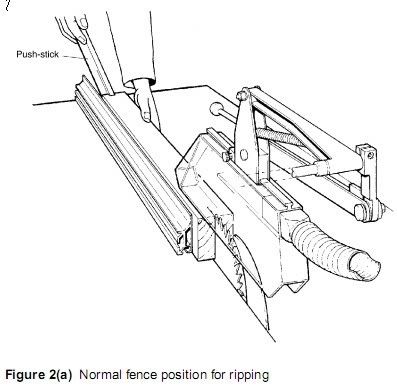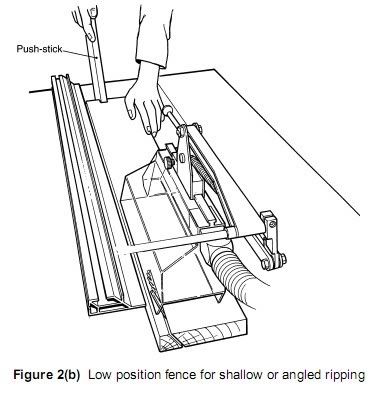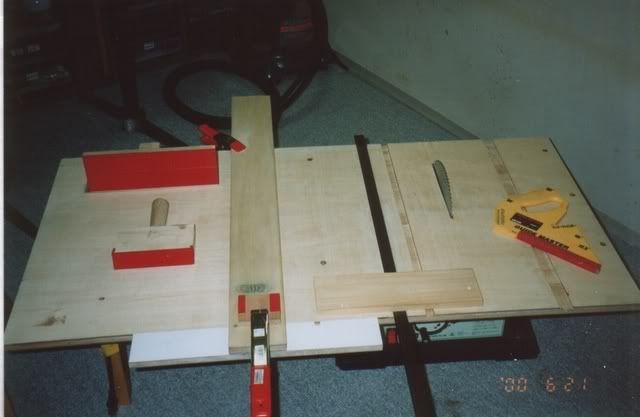niki
New Member

Posts: 38
|
Post by niki on Sept 17, 2008 22:16:23 GMT
Good day
I never had a kickback but I'm still afraid of it and take all the precautions to prevent it.
The situation...
I'm using the riving knife and the crown guard as usual but....
I'm using a "Long Fence" to rip solid wood.
Will the riving knife prevent the kickback in case of "reaction wood" that "springs out" toward the fence.
PS - The "long fence" is only for the question...I'm using "Short fence" to rip solid wood.
Thank you
niki
|
|
|
|
Post by engineerone on Sept 17, 2008 22:20:54 GMT
welcome back niki. basic answer is no it will not, all the riving knife will do is retain the centre of the wood in that place, but if that part near to the fence moves it will go off centre, and may cause kick back. i have found since i took the advice of scrit and used the fence only up to the middle of the front of the blade, i have had fewer problems with wood sticking, or burning, or kicking back. of course, the other thing is that the wood is conditioned enough so that the spring will be less. paul  |
|
|
|
Post by tusses on Sept 17, 2008 22:27:19 GMT
Hi Niki
you can also get an anti kickback riving knife that has spikes facing away from the blade and digs in to the wood if it tries to come back towards you
Rich
|
|
niki
New Member

Posts: 38
|
Post by niki on Sept 17, 2008 22:38:07 GMT
Thank you so much Paul As I said on the "PS", the long fence is only for the question. I'm using short fence. As for "reaction wood", the board in the pictures (Polish White Oak) was in my garage for 4 years but when I decided to cut it.....    If you are curious why I asked....well, I have to convince the Yankees - that are so excited from the "Euro riving knife for safety" that the riving knife itself will not prevent a kickback and they should use the "Short fence" but......they are very sceptic because "the wood is not supported after passing the blade and it can divert"...Yeap, it's not easy to change old habits....even if they are bad... Thanks again niki |
|
niki
New Member

Posts: 38
|
Post by niki on Sept 17, 2008 22:46:16 GMT
Thank you Rich
You replied while I was typing my reply to Paul....and I'm typing slowly....
Yes, I think that I've seen a riving knife with the "Anti-kickback pawls" on the sawstop or alike but...
Some time ago, a guy posted in Woodnet a "Kickback post" and he said (with picture) that the "Anti-kickback pawls just shattered to pieces and the board continued his way toward him.
I'm not so afraid from the "Push-back" because I'm using "High blade" and the main force (or vector) is down toward the table...in case of "Low blade" the main vector is back toward the operator.
Regards
niki
|
|
|
|
Post by mrgrimsdale on Sept 18, 2008 7:18:53 GMT
Thank you Rich You replied while I was typing my reply to Paul....and I'm typing slowly.... Yes, I think that I've seen a riving knife with the "Anti-kickback pawls" on the sawstop or alike but... Some time ago, a guy posted in Woodnet a "Kickback post" and he said (with picture) that the "Anti-kickback pawls just shattered to pieces and the board continued his way toward him. I'm not so afraid from the "Push-back" because I'm using "High blade" and the main force (or vector) is down toward the table...in case of "Low blade" the main vector is back toward the operator. Regards niki High blade position without a riving knife in place, with a springy board like yours, can produce a worse situation than simple kick-back. As the gap in the board closes, it grips the back of the blade, which can throw it up in the air as well as towards you. Very alarming! High blade is more dangerous, not less. Without a riving-knife a low blade position is safer, or rather; less dangerous but still risky. With a riving-knife and a long fence kick-back is unlikely, almost impossible. The riving knife prevents the board from pinching the back of the blade. Instead the workpiece simply jams tighter and becomes too difficult to push through, or slows the blade down and starts burning. Can't say I've ever had kickback in this situation, and I have cut a lot of boards. Extra safety if you have the guard in place so that if the board lifts it can't go past it. So yes - riving knife + guard is much safer without a doubt. Better with a short fence as Paul says. Where I have had kick-back, before I knew any better, was when cutting triangular sections off, to make a bevel. If one jams between the fence and the blade it can get thrown like a bolt from a crossbow and damage the saw blade in the process. This can be avoided by various false fence arrangements to give the triangular section off-cut plenty of space so it can't jam. cheers Jacob |
|
niki
New Member

Posts: 38
|
Post by niki on Sept 18, 2008 8:15:18 GMT
Hi Jacob Thank you for your reply As for "No riving knife"...well, I'm talking about "working according to the SHE safety regulations" so for me, there is no such a think like "no riving knife" (nor, "crown guard removed for clarity"). Now, I have two opposite opinions using the "long fence"....one is "kickback will happen in spite of the riving knife" and the second is, "With a riving-knife and a long fence kick-back is unlikely, almost impossible". Now I'm a bit confused but I would like to ask you.... UK (and maybe other EU countries like Germany) changed from splitter to riving knife at the 60th (source - Scrit)...If, as you are saying, kickback is unlikely and almost impossible, why they teach us to use short fence when ripping solid wood (and I think that most of the new generation table saws are coming with a fence that can be pulled back to be used as short fence...at least, my EB 255 is). Thanks niki   |
|
|
|
Post by mrgrimsdale on Sept 18, 2008 8:26:23 GMT
Hi Nicki
With a long fence, a board which isn't cutting straight can gradually wedge itself between the fence and the riving knife. This increases the slight risk of kick-back but also makes the operation difficult as it gets tighter.
With a short fence it passes through freely, even if it isn't cutting straight.
If a board is cutting perfectly straight then a long fence doesn't do anything to help paticularly, so either way it's not necessary.
cheers
Jacob
Just noticed your picture 2b. Safer than using a full fence but still can give the sling shot effect. Not a good idea IMHO.
|
|
niki
New Member

Posts: 38
|
Post by niki on Sept 18, 2008 9:17:33 GMT
Thank you Jacob As for the "High blade" that I'm using, personally, I don't see any difference if the blade protrudes 1/4" above the workpiece or 2" above the workpiece....when I'm cutting a 2½" thick wood the blade is at 3" height so what is the difference if the wood thickness is only 1". From my (limited) experience, with high blade, the feed rate is faster and that means that it's also easy on the motor. I'm talking only about solid wood and not man-made boards that I use "low blade" for cleaner cut. As for picture 2b....it's only a drawing...you should see the REAL one      You can call me "Kamikaze", it's ok....  Regards niki |
|
|
|
Post by mrgrimsdale on Sept 18, 2008 9:32:50 GMT
depends on details, but if there is any risk of kick-back, a high blade also increases the risk of kick-up into the air.
Worst case scenario - workpiece gets thrown up, falls back on to the top of the blade and gets thrown forwards too.
|
|
niki
New Member

Posts: 38
|
Post by niki on Sept 18, 2008 9:43:37 GMT
You are correct Jacob But, at least in my case, it shall have to break the crown guard bolt (wing nut) first... I think that using short fence will not let the kickback to happen in the first place because - in my opinion- "no fence = no binding = no kickback". If you want to see a real kickback, please watch this video www.metacafe.com/watch/910584/table_saw_kickback_demonstration/Regards niki |
|
|
|
Post by big-all on Sept 18, 2008 9:59:19 GMT
you are never completly safe from "kickback"
just get into the habit of standing to one side so you dont become the bulls eye on the kick back dart board
|
|
|
|
Post by Sgian Dubh on Sept 18, 2008 12:20:01 GMT
".... I have to convince the Yankees - that are so excited from the "Euro riving knife for safety" that the riving knife itself will not prevent a kickback and they should use the "Short fence" but......they are very sceptic because "the wood is not supported after passing the blade and it can divert"...Yeap, it's not easy to change old habits....even if they are bad... niki You are coming to that subject rather late in the day Niki. I've been working on the Americans for nearly decade via woodworking forums to try and improve their table saw work habits and techniques, eg, www.woodcentral.com/cgi-bin/readarticle.pl?dir=powertools&file=articles_108.shtmlIf you go to Knots or WoodCentral and do a search I'm pretty sure you'll find my Sgian Dubh handle will pop up pretty frequently in table saw safety discussions. Those are realy the only two woodworking forums I visit regulalrly and actually contribute to Stateside. In fact, now that I think about it, I only visit four woodworking forums on a regular basis, this being one of them; and I think this might be my first visit here in a week or more. I also drop in at UKWorkshop fairly often, so that's my forum activities pretty much covered, ha, ha. Slainte. |
|
|
|
Post by mrgrimsdale on Sept 18, 2008 13:41:22 GMT
interesting, two different accounts.
Personally I wouldn't do what Barb says "prepare one straight reference edge to run against a fence" except for removing obvious excrescences, as by the time you've finished the cut, the board will likely have moved a bit and will need planing again, so you'd have done it twice and could end up losing too much wood.
Nor the high blade. Or the feathers - you want it to move freely to avoid jamming or kickback.
cheers
Jacob
|
|
niki
New Member

Posts: 38
|
Post by niki on Sept 18, 2008 15:35:46 GMT
Thank you Sgian I've seen the article on the link that you gave me some one year ago (I think that, the pictures are too small and not so clear). A decade ago...I was still in Japan just starting my woodworking hobby and reading Jim Tolpin's and Ian Kirby's books about table saw operation. Just lately, looking again at those books, I've noticed that both of them recommend the use of short fence for ripping solid wood. You can see Ian Kirby's recommendation here www.rockler.com/blog/index.cfm?commentID=215And Jim Tolpin's, here books.google.com/books?id=BYW4RSLPT40C&pg=PA79&lpg=PA79&dq=Table+saw+short+fence&source=web&ots=iTKa01i1kD&sig=Wj2kV6mVQtK9JIAg0RPGRRrntKY&hl=en&sa=X&oi=book_result&resnum=9&ct=resultI posted those links in one of my replies but still nobody was "exited" from the short fence idea... I started to use the short fence just 2 years ago after reading the HSE files about safe operation of saw benches. The Riving knife is relatively new in USA and it's incorporated in a few "new designed 2008 models" as an UL demand, not OSHA safety regulation (I'm sure that you already know all that) so, there are many talks about the "Euro riving knife magic". Somehow, I don't believe that the riving knife itself can totally prevent a kickback otherwise, the HSE would not spend "time and money" to show and recommend the short fence....and the HSE is taking into consideration that we do use a riving knife as per the regulations. As for standing "out of the line of fire", it's very unclear what (or where) is this "line of fire".....if you'll watch the video on the link that I posted in one of the posts above, you can see clearly that, the wood is pushed up, climbs on top of the blade, turned counter clockwise, and propelled like a flying saucer to the left and, if the operator stands on the left side of the blade the flying saucer will take him to visit new and unknown worlds  Unfortunately, most if not all of the table saws are made in such a configuration that the operator must stand on the left of the blade, especially, if an Infeed table is used (as you can see on my pics above). So, I'm really confused about this "line of fire" and that's the reason that I think (and it's only me) that, it would be safer if the rip fence was located on the left side of the blade so the operator can stand not only out of the line of fire (that in this case the wood will be propelled to the right side of the blade) but beyond the fence (to the left of the fence) and than, he is out of all the "lines of fire" and in case of abnormal/emergency, instinctively, pull his hands toward him self without passing his hand over the blade, guarded or not.....I worked like that for 10 years without a single incident till I changed my table saw to a "normal" table saw (see the pic below...sorry, no splitter no guard). Oh well, so we shall read a few more posts about "Kickback" and again everybody will reply "sorry to here...get well quickly...I always stay out of the "line of fire" etc..... Regards niki  |
|
|
|
Post by Sgian Dubh on Sept 18, 2008 22:38:39 GMT
Somehow, I don't believe that the riving knife itself can totally prevent a kickback You are right-- it doesn't. even with the use of crown guards and the short set fence kickback can still occur, but the likelihood is definitely much reduced. Always likely to happen if you demonstrate kickback using a fully exposed blade. A saw configured and used as you postulate means you are reaching over and pulling the wood into the fence, which is a 'weak' way of working. Pushing the wood tight to the fence works with the machine and, perhaps more importantly, with the natural strength of the body. True, you're not fully out of the line of fire, but a powerful feeding method makes kickback less likely to happen. Slainte. |
|
niki
New Member

Posts: 38
|
Post by niki on Sept 18, 2008 23:20:33 GMT
Thank you so much Sgian Yes, you are very correct, with my right hand I was pushing the board - and pushing it toward the fence and with my left hand, I was reaching across the blade and puling it toward the fence but just as a guide, the main pushing force was with my right hand and at the end with push stick/shoe As I said, I didn't have any incident for 10 years, so let's call it.......Beginners luck ?  Best regards niki |
|
niki
New Member

Posts: 38
|
Post by niki on Sept 23, 2008 18:58:05 GMT
Good day
I've sent an e-mail to Metabo regarding the rip fence position and today, I got this reply and I thought that, maybe you'll be interested to see the reply...
Dear customer,
thank you for your email regarding the setting possibilities of the rip fence.
Reactive woods (not dead woods) can move to the side just after cutting. That´s why there might be the risk of a kick back if the rip fence is set in the long position.
In order to minimize this it is recommended to set the end of the rip fence to the saw blade centre (short position).
For sawing dead wood like chipboards it is recomended to set the rip fence in the long position in order to achieve the maximum guiding length.
The riving knife is absolutely necessary and the correct position of the rip fence has to be chosen according to the wood!
If you have further questions please feel free to contact me.
Furthermore enjoy woodworking!
With best regards
-------------------------------------------
Florian Fischer
Produktmanager Holzbearbeitung
Product Manager Woodworking
Phone: +49 (0) 70 22-72-2529
Fax: +49 (0) 70 22-72-2074
Email: ffischer@metabo.de
metabo
work. don't play.
|
|